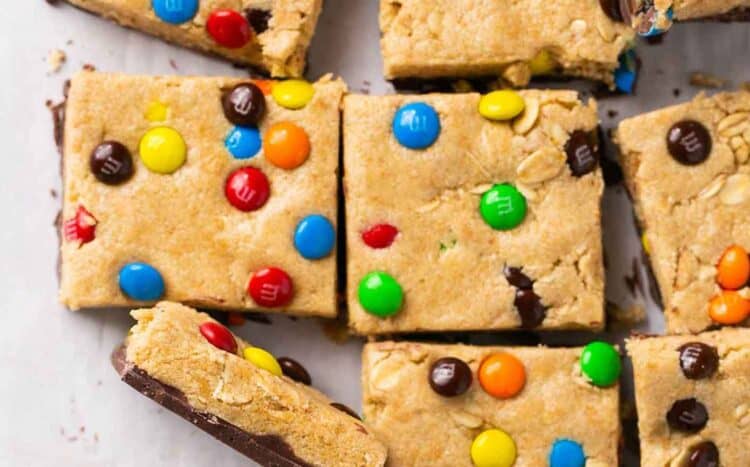This post may contain affiliate links. Please read my disclosure policy.

Topic #2
In this post we’ll cover what macros are, their purpose and the difference of tracking macros versus tracking calories for fat loss and gaining muscle. So let’s get into it!
WHAT ARE MACROS?
“Macronutrients are essential nutrition components that are needed in larger quantities by the human body,” explains Julie Stefanski, RDN who is a spokesperson for the Academy of Nutrition and Dietetics. “Hence the word “macro” as opposed to “micro,” in “micronutrients.”
Your body needs these nutrients in larger amounts in order to function optimally. Not only do they provide energy in the form of calories, but they are necessary in all the components the body needs to maintain its structures and functions.
Essentially, macros are what calories are made of. The three macronutrients are carbohydrates, proteins and fats and they each serve a different and important role in your body.
Macros are measured in grams. Each gram of a given macronutrient is equivalent to a specific number of calories.
- 1g of protein = 4 calories
- 1g of carbohydrates = 4 calories
- 1g of fat = 9 calories
MACROS VERSUS CALORIES
It is important to note that calories are king, and they are what ultimately determine weight loss, weight gain, or you are maintaining at your current weight.
If you eat more calories than the calories your body needs to maintain weight, you will gain weight (bulk). If you eat fewer calories than your body’s maintenance level you will lose weight (cut). If you eat the same amount of calories your body needs to maintain its current weight, you will not gain or lose (maintenance).
So why is it important to track macros vs just tracking calories if calories are king?
Yes, the number of calories is ultimately what determines weight loss or weight gain, but macronutrient ratios are what influence our body composition and optimal health rather than just weight loss or gain.
Macronutrients are the difference in losing weight from fat vs losing weight from muscle. Macronutrients are the difference between becoming toned or skinny fat.
A proper balance of macronutrients is the KEY (along with weight lifting) to help you achieve that lean, “toned” body.
Each macronutrient serves a purpose in the body and being a bit more concise in your tracking (as opposed to just tracking your calories) will allow you to be make smarter, more scientifically proven actions that will optimize your potential to reach your specific goals (fat loss, muscle gain, etc.)

What is the purpose of each macronutrient in the body?
Protein is necessary to build muscle and preserve muscle mass. When you exercise, you are actually damaging the muscle tissue, so to repair that damaged tissue, we need adequate protein intake!
Carbohydrates are the body’s main source of energy. It is broken down into glucose before being absorbed into the bloodstream. Glucose is what the body utilizes for energy, including not only exercise, but also normal daily activities and simply breathing. Adequate carbohydrates ensures that we are not burning muscle (protein) for energy instead. Carbs also play a huge role in the health of your Thyroid (engine for your metabolism).
Fats are a source of essential fatty acids. They are essential to the diet because the body cannot make them itself. Sufficient Fat intake is necessary for production of vital hormones (including estrogen, progesterone, testosterone, serotonin, and a variety of others. These hormones are vital in maintaining cell processes and critical for brain development and nerve function.
I also want to make a note that “tracking” macros is not something that you are going to have to do forever once you start. Taking a year, or even a couple of months to track your macros will give you the proper knowledge of serving sizes and macronutrient ratios that will allow you to continue to reach your BEST reach your goals without tracking in the future.
How to start tracking macros:
The first thing you will need to do is download an App that tracks not just calories, but also macronutrients. My go-to is MyFtinessPal, but there are also other amazing ones (MyMacros, LoseIt, LifeSum) that have positive reviews as well.
Next, you will need to buy a food scale. Any basic one that measures grams and ounces will do. I got mine cheap off of Amazon and have been using it for 2 years now will zero problems. This is the one here:

Ozeri ZK14-S Pronto Digital Multifunction Kitchen and Food Scale, Elegant Black
Practice measuring out food:
The more comfortable you become with tracking, the MORE likely you will be to stick to it! So practice tracking the food you intake.
Weigh food out on the scale or click on the barcode icon to scan the item. Get in the habit of tracking every single thing you eat or drink.
Special Considerations when it comes to tracking:
- You can STILL eat out. You are not a slave to the food scale and nor should you be. Most restaurants have nutritional information online that you can easily put in (or simply look up in the App). If they don’t, use look for a restaurant that is similar. (Ex: for a local Italian restaurant, find a similar item from Olive Garden).
- Make sure to differentiate whether the meat is cooked or raw when putting it in your App. Most barcodes will list the meat as raw on the package, but when you cook it, that amount can change by a lot. What I do instead is look up the meat I am eating and put “cooked” behind it. For instance, I wouldn’t scan the barcode on the 96/4 ground beef I am making because I like to cook it all first and then measure it out as I eat it. Instead, I just type in “(96/4 ground beef cooked” in the search bar, and it comes up with a more accurate nutritional count.)
- Learn what portion sizes look like so that you can guesstimate when nutritional information or a food scale is not available. Like I said, the goal is to not to be a slave to the food scale! This learning of portion sizes comes with time, but it is important to be observing just how much 2 tablespoons of peanut butter is, or 4 oz of chicken breast is when you ARE measuring, so that you are more aware when you are eyeballing the amount in the future.

Now that I understand the basics, how do I start tracking?
There are ton of online calculators out there that will factor in your age, weight, activity level, etc. to determine what your “maintenance calories” should be. I am personally not a fan of these because I have found them to be inaccurate for most people!
As well as taking all that information above in, it is important to more accurately determine your current caloric intake, whether or not you are maintaining on that, as well as your dieting history.
In my next post, I will lay out how to BEST determine your macros based on your current habits and goals.
In the meantime, START tracking your food intake to determine the amount of calories you are currently eating. This data will be essential for us to most accurately set your macros to ultimately best achieve your goals!
PREVIOUS: The Science of Fat Loss: How to Diet for Maximum Success (Topic #1)
NEXT: The Science of Fat Loss: How to Determine your Calories and Macros for a Calorie Deficit Phase (Topic #3)

